The Need of the Hour: How Training Evaluation Can Transform Your Programs
- Thinkdom
- Mar 23, 2023
- 7 min read
Updated: Oct 9, 2024

Table of Contents
What is Training Evaluation?
The evaluation process benefits by assessing usefulness, improving workflow, and boosting employee engagement. This can include a variety of methods such as surveys, focus groups, and performance assessments. The purpose of training evaluation is to identify strengths and weaknesses in the training program and make improvements as needed.

What is the Need for Training Evaluation?
Organizations invest a significant amount of time, resources, and money into employee training programs. However, without a way to measure the effectiveness of these programs, it's difficult to know if they're actually providing a return on investment. This is where training evaluation comes in.
By evaluating the effectiveness of training programs, organizations can ensure that they're meeting their goals and objectives. Training evaluation provides valuable insights into what's working and what's not, allowing organizations to make data-driven decisions about how to improve their training initiatives.
What are the advantages of Training Evaluation?
Identifies Areas for Improvement: Training evaluation helps identify areas where training programs can be improved. This can include changes to the content, format, or delivery method of the training.
Measures Effectiveness: Training evaluation allows organizations to measure the effectiveness of their training programs, ensuring that they're meeting their goals and objectives.
Supports Decision-Making: Training evaluation provides data-driven insights that support decision-making. Organizations can use the results of the evaluation to make informed decisions about how to improve their training initiatives.
What are the benefits of Training Evaluation?
Improves Employee Performance: Effective training programs can improve employee performance, resulting in increased productivity, better customer service, and higher job satisfaction.
Ensures Accountability: Training evaluation ensures greater accountability by ensuring that training programs address competency gaps and meet deliverables without any compromise. By measuring the effectiveness of the training program, organisations can hold themselves accountable for delivering a successful training initiative.
Introduces Transparency: Training evaluation provides a valuable feedback mechanism for trainers and the training process as a whole, promoting transparency. By assessing individual performance, evaluations can reveal areas for improvement and inform changes to the training methodology, making it easier to address any shortcomings.
Increases ROI: By evaluating the effectiveness of training programs, organizations can ensure that they're providing a good return on investment. Effective training programs can lead to increased revenue and profitability.
Enhances Organisational Reputation: A well-designed and effective training program can enhance an organisation's reputation as a good place to work, attracting and retaining top talent.
What are the Types of Training Evaluation?
Formative Evaluation: This type of evaluation takes place during the training process, allowing for feedback to be given and changes to be made in real-time. This evaluation is ongoing and helps trainers adjust the training program to better suit the needs of the learners.
Process Evaluation: Process evaluation examines the training program as a whole and looks at how well it was executed. This evaluation assesses the effectiveness of the training program in achieving its goals, and examines how well it adhered to the set objectives and timeline.
Outcome Evaluation: Outcome evaluation examines the results of the training program in terms of the changes in knowledge, behavior, and attitudes of the trainees. This evaluation measures the effectiveness of the training in meeting the set objectives.
Impact Evaluation: Impact evaluation examines the long-term effects of the training program on the organization, and how it has influenced its overall performance. This evaluation helps determine the value of the training program in terms of the return on investment.
What is Training Effectiveness?
Training effectiveness measures how much employee performance improves through learning, such as increased sales and communication skills, productivity, or meeting business goals. Training evaluation metrics can be used to measure this effectiveness. Let's explore what they are and how they can be applied to online training in your company.
What are examples of Training or Evaluation Metrics?
A training or evaluation metric is a quantifiable measure used to evaluate the effectiveness of the training process. It can be used to assess various aspects of learning, such as test scores, time spent on activities, and number of attempts required to pass. Ultimately, all training metrics are aimed at measuring training effectiveness.
Examples of training metrics include pass or fail rates, scoring, training experience satisfaction, training completion rates, learning dropout rates, and post-training performance.
These metrics can help identify areas for improvement in elearning content and browser compatibility, and provide insight into how employee performance has improved after training.
Return on investment (ROI) is a crucial metric that compares the financial value of the learning outcomes against the investment made to achieve those results. However, it is used at the end of the evaluation process

Believe it or not, when we asked L&D professionals what their biggest challenge was in evaluating training programs, a whopping 50% responded with 'Unclear Evaluation Metrics'!
And surprisingly, options like Training's Business Impact and Resource & Tool Scarcity fell far behind in the race
How can you ensure that your evaluation metrics are clear and effective?
To identify the appropriate metrics for training evaluation, consider the following criteria:
Proper metrics should highlight pain points and areas where employees are struggling
Examples: Completion rates for customer service training, average satisfaction score before and after the training, communication training completion rates, and effectiveness survey results.
Validate these learning metrics and assess the impact of training on employee and business performance
Examples: Sales performance metrics, productivity metrics, customer satisfaction scores, employee engagement, retention rates, and leadership ratings.
Objective and quantifiable employee performance metrics, included in job performance assessments, can motivate people and drive business growth
Examples: Percentage increase in sales revenue, number of new clients acquired, overall satisfaction ratings from customers, percentage increase in successful communication with clients, reduction in customer complaints, increase in productivity.
Follow the next steps to determine which metrics will be most relevant for training in your company
Ask key stakeholders about the most important indicators and assessment priorities.
Keep stakeholders informed and communicate your vision of training results clearly.
Track the performance of different departments and identify factors that impact their success. An LMS can help you track enrollment, course completion, and overdue assignments.
Educate department heads about training objectives and how it can improve group performance. This will set you up for success in training.
Considering your Training Evaluation methods:
Qualitative Methods: Qualitative methods include open-ended surveys, focus groups, and interviews. These methods provide rich and detailed data that can help trainers understand the underlying reasons behind the effectiveness or ineffectiveness of a training program.
Pros: Provides in-depth and detailed data; Allows for participant perspectives to be captured; Allows for exploration of topics that are not anticipated
Cons: Data can be difficult to analyze; Can be time-consuming; Results may be subjective
Quantitative Methods: Quantitative methods include standardized surveys, tests, and metrics. These methods provide objective data that can be easily measured and compared to standards or benchmarks.
Pros: Data is easily measurable and comparable; Provides objective data; Allows for statistical analysis
Cons: Data may not capture the full context; Results may be superficial; May not capture the participants' perspectives
Choosing a Training Evaluation Model
Different types of training require different metrics to evaluate their effectiveness.
In synchronous and blended learning, attendance and participation in webinars should also be considered. On the other hand, asynchronous training requires tracking learners' progress through the course modules to measure their post-training behaviour.
To measure the effectiveness of asynchronous training, metrics such as the number of completed modules, time spent on them, and test scores are crucial.
The widely used Kirkpatrick Model created by Dr. Donald Kirkpatrick can be used to create a comprehensive strategy for evaluating training effectiveness. By incorporating the appropriate training metrics into this model, you can objectively assess the impact of training on employee and business performance. Additionally, utilizing an LMS can assist in evaluating the effectiveness of training.
Kirkpatrick's Four-Level Model:
This model assesses the effectiveness of training on four levels: Reaction, Learning, Behavior, and Results. This model is widely used and helps evaluate the effectiveness of a training program in terms of its objectives.
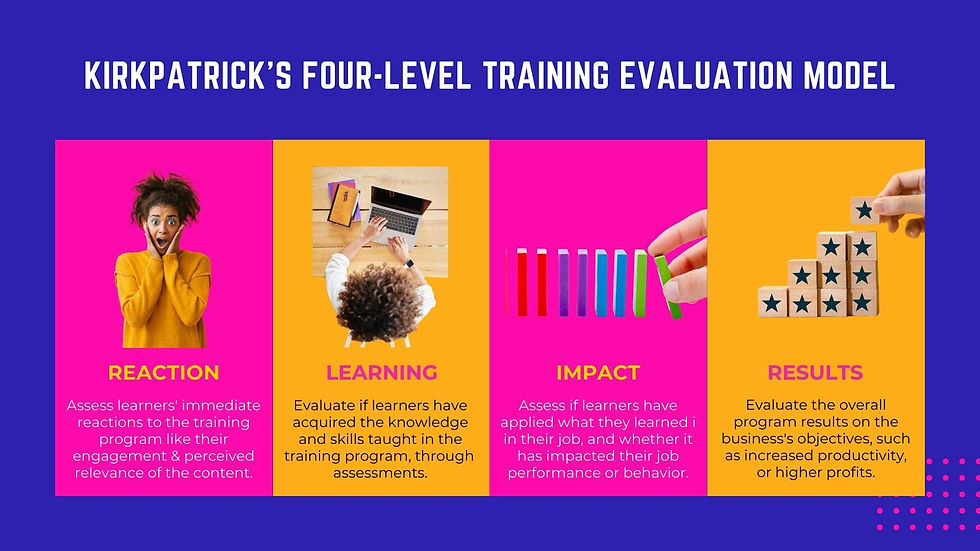
Qualities: Versatility and Popularity
Limitations: Contextual and External Factor Blindness and Measurement Difficulty
The CIRO Model:
This model evaluates training programs in terms of their alignment with organizational goals, job requirements, and individual needs. This model helps ensure that training programs are effective in achieving organizational goals.
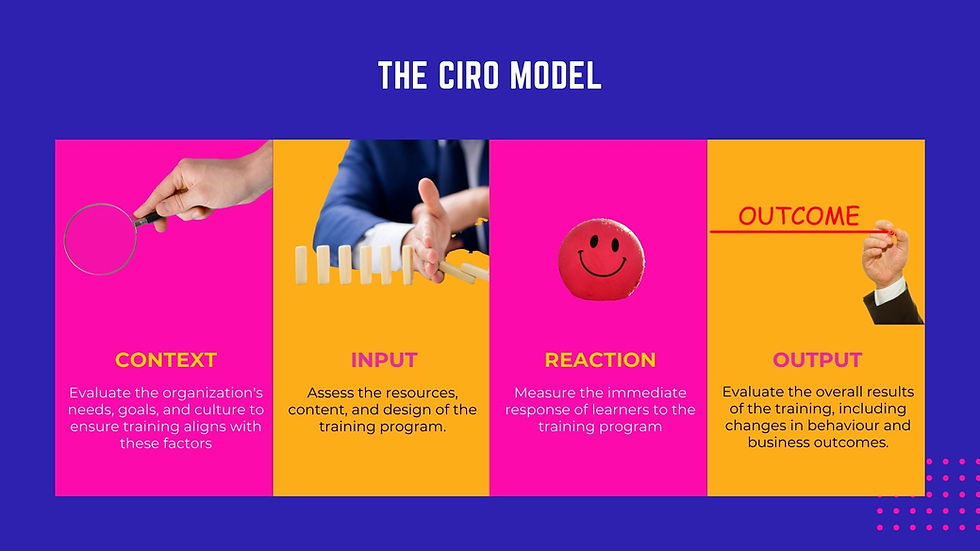
Qualities: Alignment and Effectiveness
Limitations: Complex Structure and Rapid Change Compatibility Issues and Difficulty in Aligning Needs
Phillips ROI Model:
This model evaluates training programs in terms of their return on investment. This model helps assess the effectiveness of training programs in terms of their impact on the organization's bottom line.
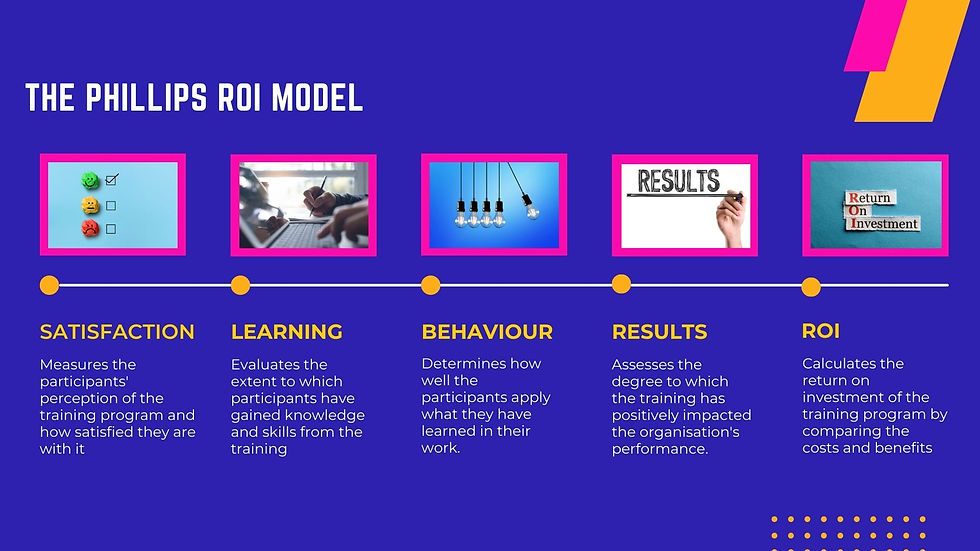
Qualities: Financial Accountability
Limitations: Practical Difficulty in Cost-Benefit Measurement and Neglect of Non-Financial Benefits
Kaufman's Five Levels of Evaluation:
This model evaluates training programs in terms of five levels: Input, Process, Output, Impact, and Feedback. This model is comprehensive and provides a holistic view of the training program.
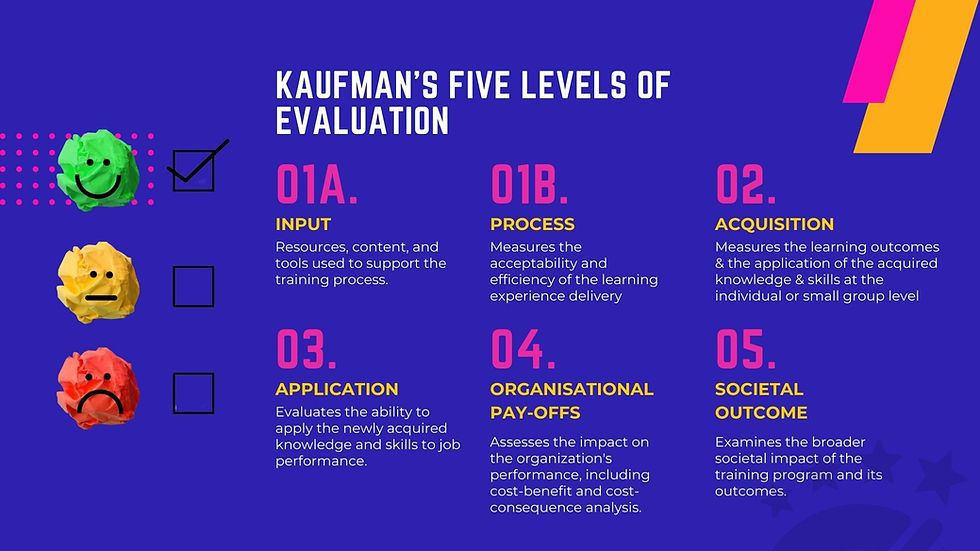
Qualities: Comprehensive Insight and Multilevel Analysis
Limitations: Time and Resource Intensiveness and Incompatibility with Smaller Organizations
Anderson's Model of Learning Evaluation:
This model evaluates training programs in terms of the knowledge, skills, and attitudes of the participants. This model helps trainers understand how well the training program met the needs of the learners.
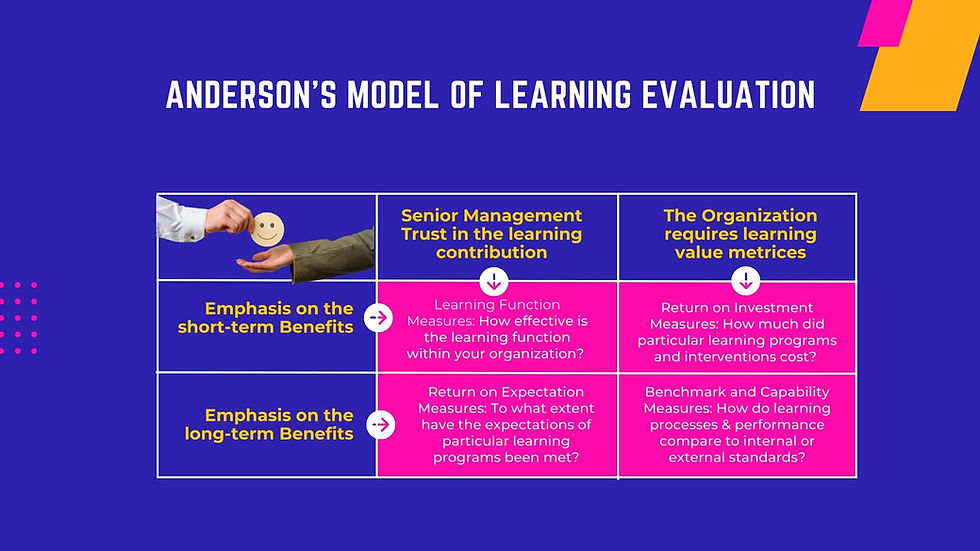
Qualities: Learner-centric Approach
Limitations: External Factor Oversight and Attitude/Belief Measurement Difficulty
There are various training evaluation models to choose from, each with its own unique features. It is important to note that these models don't have to be implemented in their entirety and can be tailored to fit the specific needs of an organization. With careful consideration, an organization can find the most appropriate approach for their situation and circumstances.
To Sum Up
Analyzing the effectiveness of your learning strategy is crucial to demonstrate its value to the company. Evaluation can uncover shortcomings, enabling you to make improvements and optimize the value of training for learners and the organization. Working with a credible partner can further enhance the evaluation process and ensure the best possible outcomes.


Comentários